Views: 68,264
Hello Friends,

Some soap makers face a problem called Dreaded Orange Spots, often referred to as DOS. These spots have been widely discussed for decades. As the soap ages, sometimes it developes areas of rusty colored spots. Most people consider them to be a sign of oxididation/rancidy of the oils. The spots start off as small round dots and will spread throughout the entire bar over time.
Dr. Kevin Dunn, known as the caveman chemist, is a professor and a soap maker. He has conducted scientific testing with his students on a number of soap making issues including the study of DOS. I attended a presentation by Dr. Dunn at the Handmade Soap Maker's Guild where he spoke about his study results. It was fascinating. I wanted to do my own experiment using Dr. Dunn's recommendations. This wasn't a scientifically controlled experiment, just a simple testing in a real time retail environment - I am not a scientist, but I am a decades long soap maker - so keep that in mind, your results may vary.
On the same day, using the same identical supplies, I made two batches of my Vestal Castile Soap. The soap is 100% certified organic olive oil, distilled water and lye. Nothing else. No fragrance, no color. I did cold process, soaped between 4 & 5% superfat. To the second batch, I added .1% each of EDTA and Sodium Citrate and .05% BHT. These are the additives that Dr. Dunn discussed in his presentation on the prevention of DOS. The EDTA and Sodium Citrate was dissolved in water, the BHT dissolved in warmed oils. Both batches were brought to full gel.
At all times, the test bars were kept together in identical curing and storage situations. They were cured in my soap studio for 8 weeks. One bar of each was put in muslin bags (I have always sold my bars in muslin), and one bar of each was left unwrapped. They were kept, untouched on a shelf in my office at the store. This would be the same retail environment as my soap cart. We only maintain the heat and AC during store hours, so the soap was exposed to some very hot humid conditions during the summer months, and 55 to 60 degree cold during the winter months.
Here are the pictures of the results. As you will note, the two bars with the additives are sparkling white, pristine with no signs of DOS. The wrapped bar with no additives shows one small, very light DOS developing in the upper right hand corner of the bar, the unwrapped bar with no additives is almost completed covered in DOS on all sides. It is also interesting to note the unwrapped, no additive bar shows great difference in shrinkage and cracking. I should have photographed these soaps throughout the year because the bar that is covered in DOS did indeed start as small round spots throughout the bar and progressed to almost total coverage. Someone speculated that it wasn't DOS but aging of the soap, but it did go through stages from typical appearing DOS to the final images.
I have always believed that selling in muslin gives the best protection. I have had bars deteriorate on the display shelf while the same batch bars in the muslin bags stay perfect. When I compare the bars that had no additives, the one that was unwrapped is drastically impacted by exposure to light and air. My belief that muslin is best for my soap have been validated. The results of this experiment also show that simple muslin packaging provided similar protection against DOS as did the chemical additives - at least in my uncontrolled test environment.
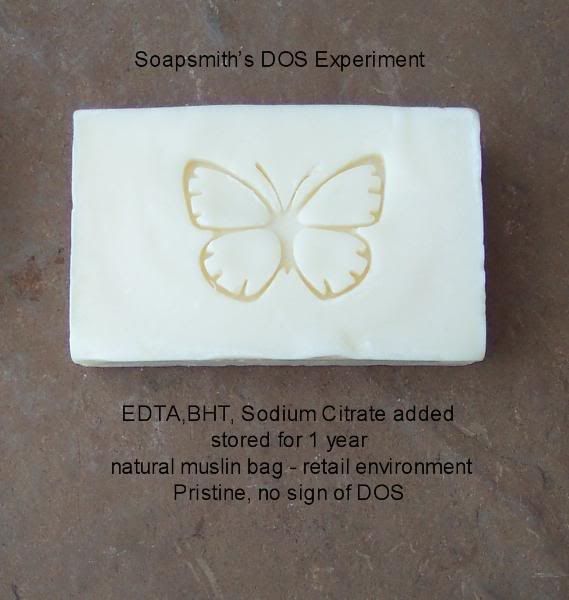
[
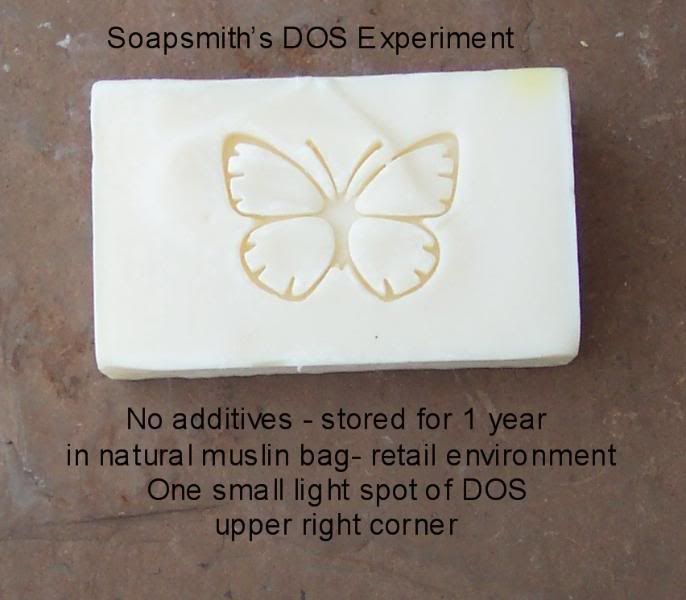
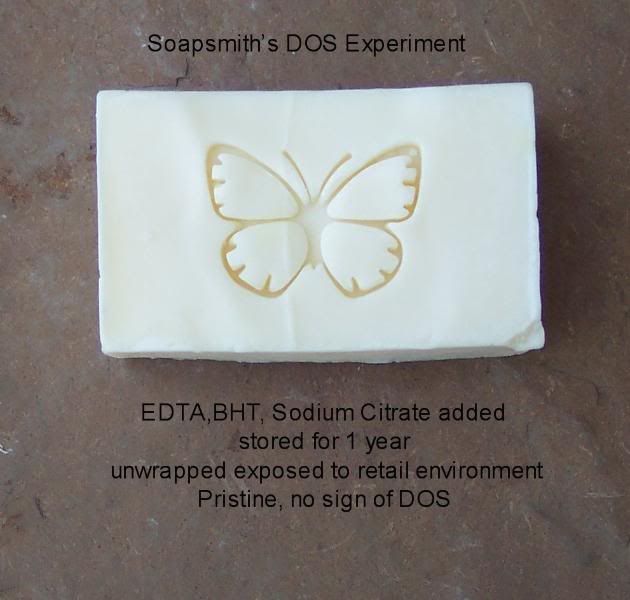
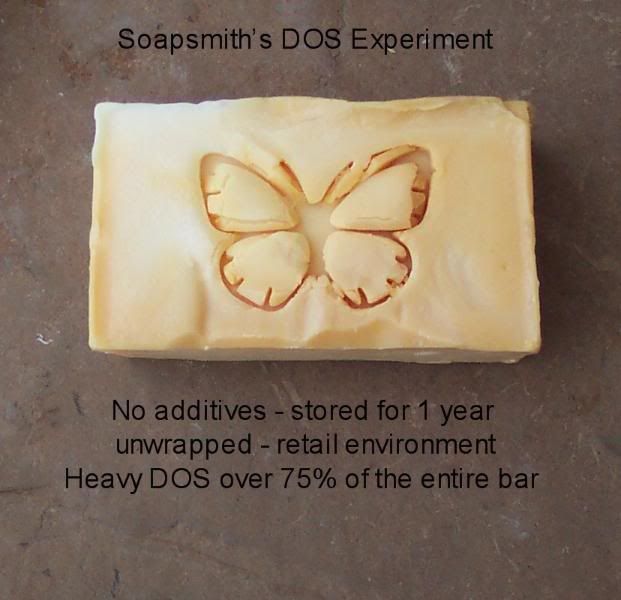
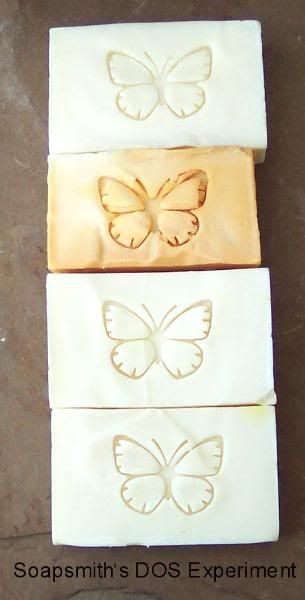
The top bar is the additives in muslin, next is no additives unwrapped, next is additives unwrapped, and last is muslin no additives, note the faint yellow spot in the upper right hand corner of the last bar.
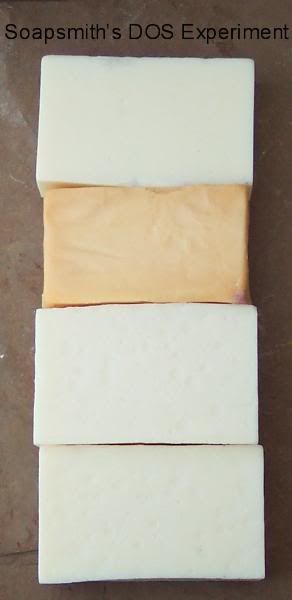
This is the back side of the same bars.
The pictures are not enhanced, they are taken in natural light. I hope this provides some useful information to my fellow soap makers.
Happy soaping!
Bonnie
By Soapsmith on 12/14/2014 @ 03:19am
I dissolved it in 2 ounces of water and blended that into the oils with the stick blender. Same with the BHT, I dissolved it into 2 ounces of warm oils and blended that in before I added the lye water. I did the lye into the remaining water for the batch then added that to the pot of oils that already contained the additives..
By Guest on 12/14/2014 @ 03:04am
Hi, Did you add the Sodium Citrate and EDTA to the water before you added the lye or did you do it separately?
By Guest on 10/16/2014 @ 05:35pm
Hi Bonnie, The good experiments stay forever...like this one! it is very good and informative. Thank you for sharing your experience with this antioxidants, it is very helpful.
By Guest on 10/07/2014 @ 05:17pm
Thank you for your response. I enjoyed reading the results of your experiment.
By Soapsmith on 10/07/2014 @ 04:40pm
I used the weight of the oils.
By Guest on 10/07/2014 @ 04:36pm
Was your Sodium Citrate and EDTA added at .1% of the oils weight or the total weight of the batch?
By Soapsmith on 09/19/2014 @ 02:19pm
I don't use these in my soaps but when I purchased them to do this experiment a few years ago I got it at lotioncrafters. but I don't see it on their site anymore. You can get it several places: the herbarie, saveoncitric, theherbalhut, floridanaturalsupply, soapgoods. Hope that helps.
By Guest on 09/19/2014 @ 01:23pm
I had a strong case of DOS my soaps were completely covered. I had been trying to buy BHT but haven't found a place where to buy it, can you please at least gave me an idea where to look? I google it and a lot of info regarding the benefits for herpes and other things they offer BHT in capsules. This is how they sale it? Thank you for your help.
By Soapsmith on 09/10/2014 @ 12:11pm
Hello, Those products can usually be found by the terms I used on most soapmaking suppliers. EDTA, BHT, and ROE. They stand for: Ethylenediaminetetraacetic acid (EDTA) is a chelating agent which is sometimes used to cut soap scum Butylated hydroxytoluene (BHT) anti oxidant often found in cooling oils as an additive to prevent rancidity Rosemary Oleoresin Extract (ROE) anti oxidant from the rosemary plant and is also used to prevent rancidity If you are searching for them, you can use the shortened terminology but you should list them in the full written form for your labels so you are in compliance with the federal regulations. Thanks.
By Guest on 09/10/2014 @ 04:38am
This is so interesting, thanks for sharing. I am a very new soaper, so the information is very handy for me. I have to ask though, what is EDTA, BHT and ROE?
By Soapsmith on 08/27/2014 @ 12:29pm
Hello, I used Tetrasodium EDTA
By Guest on 08/27/2014 @ 08:36am
which EDTA did you use? Tetrasodium EDTA or Disodium EDTA?
By Soapsmith on 07/16/2013 @ 12:09pm
I am not sure about which oils contribute to DOS. Other soapmakers have opinions on certain oils - I seem to recall people getting more DOS with canola, some with soy, some with safflower. I have never tried other oils to see. It is very humid here, too, which plays havoc with soap making. You could experiment, make two batches the same day using the same oils and leave out the castor. Store them and see if it makes any difference.
By Guest on 07/16/2013 @ 10:28am
Thanks! I live in an extremely hot and humid environment (coastal). I am trying to figure out which oils may be contributing to DOS due to the humid environment. I use coconut oil, castor oil, extra-virgin olive oil and palm oil. I was thinking maybe the castor and olive oils? Any thoughts?
By Soapsmith on 07/09/2013 @ 04:14pm
I have heard that it helps. When Dr. Dunn tested ROE found it did provide some preventative measures but it was very minimal.
By Guest on 07/09/2013 @ 01:00pm
Thank you so much for the detailed experiment above! It was tremendously helpful! Do you know if adding ROE to the soap batches is useful to prevent DOS?s

No comments:
Post a Comment